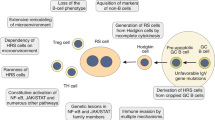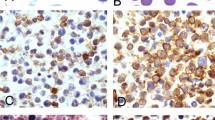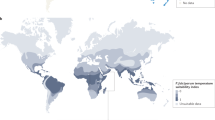Abstract
The epidemiology of Hodgkin’s disease suggests that it is a heterogeneous condition comprising more than one disease entity. The Epstein–Barr virus (EBV) is present in the Reed–Sternberg cells of a proportion of cases and is likely to play a role in the pathogenesis of these cases. In this study we show that EBV association rates vary with age at diagnosis. We suggest that Hodgkin’s disease can be divided into three disease entities on the basis of EBV association and age, thereby providing biological support for the multiple aetiology hypothesis proposed by MacMahon (Cancer Res 1966; 26: 1189–1290).
This is a preview of subscription content, access via your institution
Access options
Subscribe to this journal
Receive 12 print issues and online access
$259.00 per year
only $21.58 per issue
Buy this article
- Purchase on Springer Link
- Instant access to full article PDF
Prices may be subject to local taxes which are calculated during checkout
Similar content being viewed by others
Author information
Authors and Affiliations
Rights and permissions
About this article
Cite this article
Armstrong, A., Alexander, F., Cartwright, R. et al. Epstein–Barr virus and Hodgkin’s disease: further evidence for the three disease hypothesis. Leukemia 12, 1272–1276 (1998). https://doi.org/10.1038/sj.leu.2401097
Received:
Accepted:
Published:
Issue Date:
DOI: https://doi.org/10.1038/sj.leu.2401097
Keywords
This article is cited by
-
Latent membrane protein 1 (LMP1) expression in Hodgkin lymphoma and its correlation with clinical and histologic parameters
World Journal of Surgical Oncology (2017)
-
Distribution and features of hematological malignancies in Eastern Morocco: a retrospective multicenter study over 5 years
BMC Cancer (2016)
-
Changing patterns in the Epstein-Barr virus (EBV)and Hodgkin lymphoma association in Tunisia
Annals of Hematology (2016)
-
Incidence and time trends of childhood lymphomas: findings from 14 Southern and Eastern European cancer registries and the Surveillance, Epidemiology and End Results, USA
Cancer Causes & Control (2016)
-
DNA methylation patterns in EBV-positive and EBV-negative Hodgkin lymphomas
Cellular Oncology (2015)



